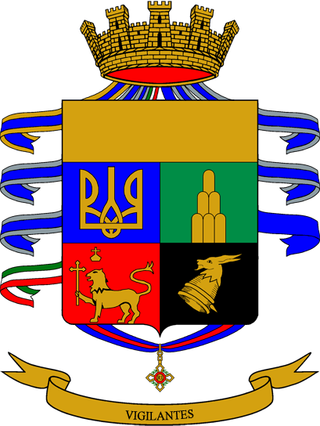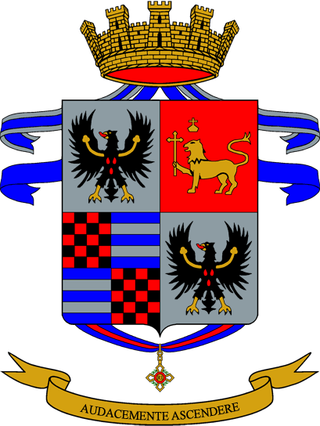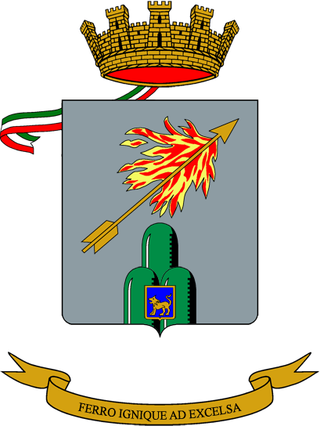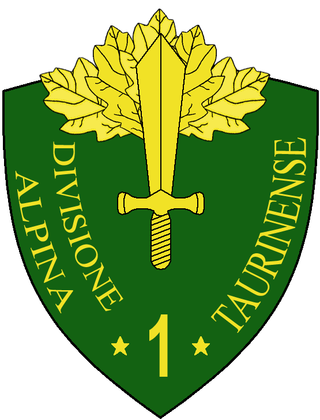
The 4th Alpine Division "Cuneense" was a division of the Royal Italian Army during World War II, which specialized in mountain warfare. The headquarters of the division was in the city of Cuneo, and the majority of its Alpini soldiers were drafted from the surrounding Province of Cuneo - hence the division's name "Cuneense". The division participated in all Italian World War II campaigns with the exception of the North African Campaign. The division was annihilated during Operation Little Saturn by Soviet forces in January 1943.

The 2nd Alpini Regiment is a mountain warfare regiment of the Italian Army based in Cuneo in Piedmont. The regiment belongs to the Italian Army's Alpini infantry speciality and is assigned to the Alpine Brigade "Taurinense". On 1 November 1882, the Royal Italian Army formed the 2nd Alpini Regiment, which had its recruiting area in the Maritime Alps and Cottian Alps. During World War I the regiment expanded to ten battalions, which fought separately in the alpine areas of the Italian front.

The 1st Alpini Regiment in a mountain warfare unit of the Italian Army based in Turin in Piedmont. The regiment belongs to the Italian Army's Alpini infantry speciality and was last active as Alpini Battalion Mondovì. On 1 October 2022, the flag and traditions of the 1st Alpini Regiment were assigned to the Command and Tactical Supports Unit "Taurinense" of the Alpine Brigade "Taurinense", which on the same day was renamed 1st Alpini Command and Tactical Supports Unit. On 1 November 1882, the Royal Italian Army formed the 1st Alpini Regiment, which had its recruiting area in the Ligurian Alps and Maritime Alps. During World War I the regiment expanded to nine battalions, which fought separately in the alpine areas of the Italian front.

The 7th Alpini Regiment is a mountain warfare regiment of the Italian Army based in Belluno in Veneto. The regiment belongs to the Italian Army's Alpini infantry speciality and is assigned to the Alpine Brigade "Julia". On 1 August 1887, the Royal Italian Army formed the 7th Alpini Regiment by splitting the 6th Alpini Regiment. The new regiment's recruiting area initially consisted of the valleys of the Bellunes Alps, Carnic Alps, Carnic Prealps, and the Western side of the Julian Alps. In 1909 the regiment was split to form the 8th Alpini Regiment and afterwards the regiment's recruiting area consisted of the Bellunes Alps.

The 9th Alpini Regiment is a mountain warfare regiment of the Italian Army based in L'Aquila in Abruzzo. The regiment belongs to the Italian Army's Alpini infantry speciality and is assigned to the Alpine Brigade "Taurinense". The regiment was formed by the Royal Italian Army on 1 July 1921. In 1935 the regiment was assigned to the 3rd Alpine Division "Julia", with which it served during World War II in the Greco-Italian War, during which the division suffered heavy losses. For its service and sacrifice on the Greek Front the 9th Alpini Regiment was awarded Italy's highest military honor the Gold Medal of Military Valor. In summer 1942 the division was transferred to the Eastern Front in the Soviet Union, where it was destroyed in winter 1942-43 during the Soviet Operation Little Saturn. The remnants of the division were repatriated in spring 1943. For its service and sacrifice on the Eastern Front the 9th Alpini Regiment was awarded a second Gold Medal of Military Valor. On 8 September 1943, the Armistice of Cassibile was announced and invading German forces disbanded the 9th Alpini Regiment.

The 1st Field Artillery Regiment (Mountain) (Italian: 1° Reggimento Artiglieria Terrestre (montagna)) is a field artillery regiment of the Italian Army, specializing in mountain warfare. The regiment is based in Fossano in Piedmont and assigned to the Alpine Brigade "Taurinense". The regiment is the Italian Army's senior mountain artillery regiment as it was formed in 1887 by the Royal Italian Army. In World War I the regiment's groups and batteries served on the Italian front.

The 2nd Mountain Artillery Regiment is an inactive mountain artillery regiment of the Italian Army, which was based in Trento in Trentino. The regiment was formed in 1915 by the Royal Italian Army as 3rd Mountain Artillery Regiment. In World War I the regiment's groups and batteries served on the Italian front.

The 3rd Field Artillery Regiment (Mountain) (Italian: 3° Reggimento Artiglieria Terrestre (montagna)) is a field artillery regiment of the Italian Army, specializing in mountain warfare. The regiment is based in Remanzacco in Friuli-Venezia Giulia and assigned to the Alpine Brigade "Julia". The regiment was formed in 1909 by the Royal Italian Army as 2nd Mountain Artillery Regiment. In World War I the regiment's groups and batteries served on the Italian front.

The 11th Alpini Regiment is an inactive mountain warfare regiment of the Italian Army last based in Bruneck in South Tyrol. The regiment belongs to the Italian Army's Alpini infantry speciality and was last assigned to the Alpine Brigade "Tridentina". The regiment was formed by the Royal Italian Army on 22 December 1935 and assigned assigned to the 5th Alpine Division "Pusteria", with which it participated in the Second Italo-Ethiopian War.

The 12th Alpini Regiment is an inactive mountain warfare regiment of the Italian Army last based in Pieve di Cadore in Veneto. The regiment belongs to the Italian Army's Alpini infantry speciality and was assigned to the Alpine Brigade "Cadore". The regiment was formed in 1992 and consisted of the Alpini Battalion "Pieve di Cadore", whose flag and traditions it inherited.

The 5th Mountain Artillery Regiment is an inactive mountain artillery regiment of the Italian Army, which was based in Meran in South Tyrol. The regiment was formed in 1935 by the Royal Italian Army with batteries that had served in World War I. The regiment was assigned to the 5th Alpine Division "Pusteria", with which it served in the Second Italo-Ethiopian War and during World War II in the invasion of France and the Greco-Italian War. After the invasion of Yugoslavia the regiment served as occupation force in Montenegro. In 1943 the regiment was transferred to the South of occupied France. After the announcement of the Armistice of Cassibile on 8 September 1943 the regiment was disbanded by invading German forces.

The 4th Mountain Artillery Regiment is an inactive mountain artillery regiment of the Italian Army, which was based in Susa in Piedmont. The regiment was formed in 1934 by the Royal Italian Army with mountain artillery groups that had served in World War I. The regiment was assigned to the 4th Alpine Division "Cuneense", with which it served during World War II in the invasion of France and the Greco-Italian War. In summer 1942 the division was transferred to the Soviet Union, where it was destroyed in winter 1942-43 during the Soviet Operation Little Saturn. The remnants of the division were repatriated in spring 1943 and invading German forces disbanded the division and its regiments after the announcement of the Armistice of Cassibile on 8 September 1943.

The 16th Regiment "Belluno" is an inactive mountain warfare regiment of the Italian Army last based in Belluno in Veneto. The regiment belongs to the Italian Army's Alpini infantry speciality and was a training unit last assigned to the Alpine Troops Command. The regiment was formed in 1991 and consisted of the Alpini Battalion "Belluno", whose flag and traditions it inherited.

The 6th Mountain Artillery Regiment is an inactive mountain artillery regiment of the Italian Army, which was based in Bassano del Grappa in Veneto. The regiment was formed in 1941 by the Royal Italian Army with batteries that had served in World War I and been disbanded after the war. During World War II the regiment served in 1942 as occupation force in Montenegro and in 1943 in Liguria as coastal defence unit. After the announcement of the Armistice of Cassibile on 8 September 1943 the regiment was disbanded two days later by invading German forces.

The 3rd Alpine Division "Julia" was a division of the Royal Italian Army during World War II, which specialized in mountain warfare. The Alpini that formed the divisions are a highly decorated, elite mountain corps of the Italian Army comprising both infantry and artillery units. Today the traditions and name of the 3rd Alpine Division "Julia" are carried on by the Alpine Brigade "Julia".

The 1st Alpine Division "Taurinense" was a division of the Royal Italian Army during World War II, which specialized in mountain warfare. The Alpini that formed the division are a highly decorated and elite mountain corps of the Italian Army consisting of both infantry and artillery units. Today, the traditions and name of the 1st Alpine Division "Taurinense" are carried on by the Alpine Brigade "Taurinense". The headquarters of the division was in the city of Turin and the majority of its soldiers were drafted from the surrounding Province of Turin — therefore the division was named "Taurinense" for the Roman name of the city of Turin Augusta Taurinorum.

The 2nd Alpine Division "Tridentina" was a division of the Royal Italian Army during World War II, which specialized in mountain warfare. The Alpini that formed the divisions are a highly decorated and elite mountain corps of the Italian Army comprising both infantry and artillery units. The name Tridentina was chosen as the division was based in the Trentino-South Tyrol region, for which the fascist regime of Benito Mussolini had created the neologism Venezia Tridentina. After World War II, the traditions and name of the 2nd Alpine Division "Tridentina" were carried on by the Alpine Brigade "Tridentina".

The 1st Infantry Division "Superga" was an infantry division of the Royal Italian Army during World War II. The Superga was classified as a mountain infantry division, which meant that the division's artillery was moved by pack mules instead of the horse-drawn carriages of line infantry divisions. Italy's real mountain warfare divisions were the six alpine divisions manned by Alpini mountain troops. The Superga recruited primarily from central Piedmont and was based, together with its two infantry regiments, in Turin, while the 5th Artillery Regiment was based in Venaria Reale. The division was and named for the Superga hill near Turin, where members of Italy's Royal House of Savoy were buried in the Basilica of Superga.
The Italian Army in Russia (ARMIR) was a field army of the Royal Italian Army in World War II, which was deployed to the Soviet Union in July 1942. Upon arrival on the Eastern Front the army consisted of the following units:

The Mountain Artillery Group "Belluno" is an inactive mountain artillery group of the Italian Army, which was based in Pontebba in Friuli-Venezia Giulia. The group was formed on 1 October 1909 by the Royal Italian Army's 2nd Mountain Artillery Regiment and served with the regiment during World War I on the Italian front. In World War II the group was assigned to the 5th Alpine Artillery Regiment "Pusteria", with which it participated in the invasion of France and the Greco-Italian War.



















